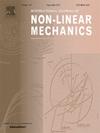Stochastic dynamics analysis of quasi-partially integrable Hamiltonian system based on NN-SAM
IF 2.8
3区 工程技术
Q2 MECHANICS
International Journal of Non-Linear Mechanics
Pub Date : 2024-12-25
DOI:10.1016/j.ijnonlinmec.2024.104993
引用次数: 0
Abstract
Stochastic response and reliability analysis of quasi-partially integrable Hamiltonian systems are two important yet difficult problems due to high dimensionality and nonlinearity. Deep neural networks (DNNs) and the stochastic averaging method (SAM) can address the difficulty of system dimensionality in their own ways. This paper proposed a method called NN-SAM by merging physics-informed neural networks (PINNs) and SAM to solve the stochastic response and reliability of multi-dimensional quasi-partially integrable Hamiltonian systems. Firstly, by analyzing the resonance for quasi-partially integrable Hamiltonian systems, the averaged stochastic differential equations (SDEs) with less dimension for resonant and non-resonant cases through SAM are derived, respectively. Based on these averaged SDEs, the averaged Fokker–Planck–Kolmogorov (FPK) equation, the backward Kolmogorov (BK) equation and Pontryagin equation are obtained with mixed boundary conditions, including reflecting boundary, absorbing boundary or periodic boundary. Then, the PINNs are constructed for the response prediction and reliability assessment of the non-resonant case, including solving the averaged FPK equations, the BK equation and Pontryagin equation with or without periodic boundary conditions. For the resonant case, periodic layers are introduced as a hard constraint to the neural network to handle the periodic boundary conditions caused by resonance. Finally, two numerical examples are worked out and verified by the results from the Monte Carlo (MC) simulation. This work provides an effective technique for the stochastic response and reliability problems of quasi-partially integrable systems.
求助全文
约1分钟内获得全文
求助全文
来源期刊
CiteScore
5.50
自引率
9.40%
发文量
192
审稿时长
67 days
期刊介绍:
The International Journal of Non-Linear Mechanics provides a specific medium for dissemination of high-quality research results in the various areas of theoretical, applied, and experimental mechanics of solids, fluids, structures, and systems where the phenomena are inherently non-linear.
The journal brings together original results in non-linear problems in elasticity, plasticity, dynamics, vibrations, wave-propagation, rheology, fluid-structure interaction systems, stability, biomechanics, micro- and nano-structures, materials, metamaterials, and in other diverse areas.
Papers may be analytical, computational or experimental in nature. Treatments of non-linear differential equations wherein solutions and properties of solutions are emphasized but physical aspects are not adequately relevant, will not be considered for possible publication. Both deterministic and stochastic approaches are fostered. Contributions pertaining to both established and emerging fields are encouraged.

 求助内容:
求助内容: 应助结果提醒方式:
应助结果提醒方式:


